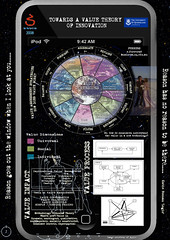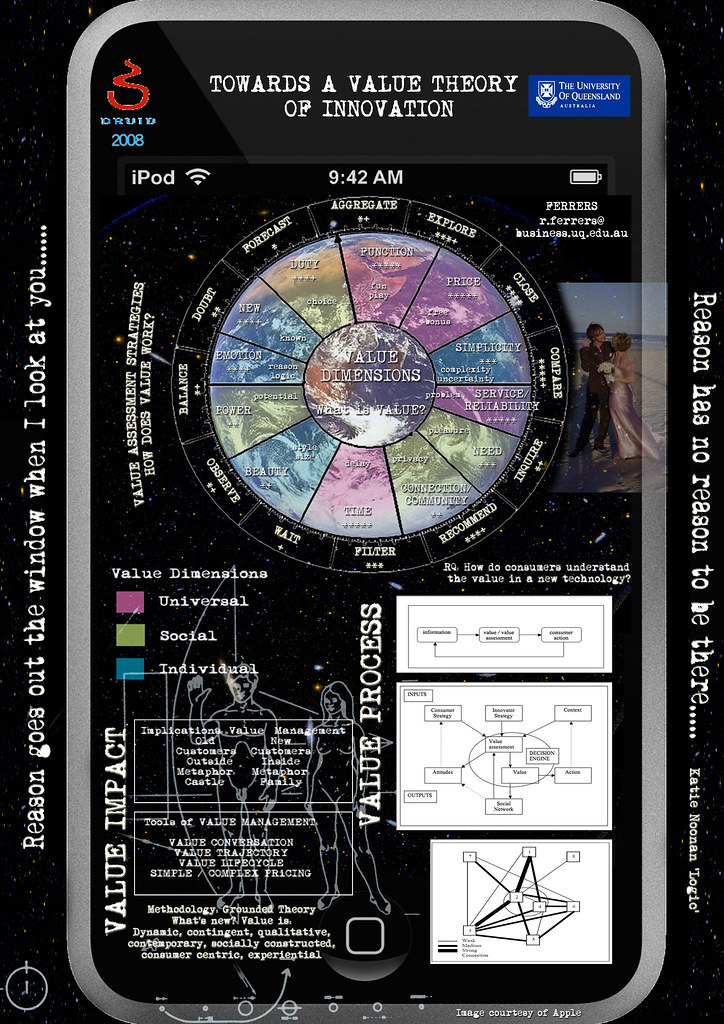Tuesday, January 20, 2009
Measuring Innovation - UK Style
There are four projects:
- measuring corporate innovation 500k GBP
- innovation growth accounting 250k GBP
- framework conditions for innovation 75k GBP
- measurng user led innovation 100k GBP
See details at Innovation Index, with Research Notes, and Guidelines for tendering.
Look at my tender for a value approach to measuring innovation, at a national level.
The key is engaging consumers to vote for which innovations create value for them, using a website, built for that purpose. Obama's change.gov website, and tools therein is a model for this approach.
Happy inauguration day!
Saturday, January 10, 2009
Imagine. Create. Innovate.

Europe has decided 2009 is their year of Creativity and Innovation.
The goals are taken from their website www.create2009.europe.eu:
The European Year of Creativity and Innovation has the objective to raise awareness of importance of creativity and innovation for personal, social and economic development, to disseminate good practices, stimulate education and research, and promote policy debate and development.
The Year addresses a wide spectrum of related themes such as:
- fostering artistic and other forms of creativity through pre-school, primary and secondary education including vocational streams, as well as non-formal and informal education
- maintaining engagement with creative forms of self-expression throughout adult life
- cultural diversity as a source of creativity and innovation
- information and communication technologies as media for creative self-expression
- ensuring that mathematics, science and technological studies promote an active, innovative mindset
- developing a wider understanding of the innovation process and a more entrepreneurial attitude as prerequisites for continued prosperity
- promoting innovation as the route to sustainable development
- regional and local development strategies based on creativity and innovation
- cultural and creative industries including design – where the aesthetic and the economic coincide.
For your consideration.
Upside Down-novation (Denovation)

Innovation has traditionally defined around something ‘new’. Schumpeter talked of new products, services, business models (Schumpeter 1934), and indeed the ‘nova’ in innovation is Latin for ‘new’. Recent definitions of innovation have included the related concept of value and value creation. For instance, the Innovation Metrics project, sponsored by the US Department of Commerce, and whose board includes elite business and academics define innovation as ‘something new that creates value’. The 2008 Australian National Innovation Review uses a similar definition (Cutler 2008).
However, by linking innovation and value some terminology issues have arisen. I have been writing my PhD about how consumer understand value in a new technology. This research aims to better understand innovation from a consumer perspective, and uses consumer interviews and a grounded theory methodology (see Ferrers(2008)). Some terminology issues have arisen.
The first issue builds from Schumpeter’s idea of creative destruction. When innovation creates, it builds upon the destruction of the old ways. As innovation creates value, so it destroys value. But we seem to lack a word to indicate this destruction. If innovation is something new, which creates value, what do we call – something new which destroys value. My suggestion in this note is that we need a new term for this idea. Such a word emphasises the value impact of the new. We have innovation for a positive impact, and we need a word for a negative impact.
A few possibilities have come to mind. These words use negative prefixes to indicate destruction. Prefixes such as ‘un’, ‘contra’, ‘min’, ‘anti’, or ‘de’ could be used, and connected with innovation. Thus possibilities are un-novation, contra-vation, min-novation, anti-innovation and de-novation.
Value similarly suffers from a lack of negativity. This is a second terminology issue, Value can be a noun or a verb. Something has value or we may value something. Both meanings are positive. However, we seem to lack a word which means loss of value, or negative value. Elsewhere I have argued that value moves either up or down, with new information and relates to several dimensions such as price, time and function (Ferrers 2008). What I now argue for is a new terminology to capture this negative action and movement. A price rise or something that wastes our time destroys value, yet we would not call the change and innovation or new value. I propose that we call a loss of value event, a ‘devalue’ or ‘devaluation’.
In short, I portpose two new words to complement innovation and value. I suggest we use ‘denovation’ to be the opposite of innovation and use this word to denote something new which destroys value. Also, I suggest we use ‘devalue’ as the noun related to a loss of value. I look forward to you comments.
References:
Schumpeter, JS 1934, Theory of Economic Development (per http://en.wikipedia.org/wiki/Innovation)
Cutler T 2008, Australian National Innovation Review, available online at www.innovation.gov.au
Ferrers R 2008, Towards a value theory of innovation, DRUID conference, Copenhagen (online here).
Tuesday, November 11, 2008
Measuring Innovation - Some 2008 reports
Boston Consulting Group (Aug. 2008)
Innovation 2008: Is the Tide Turning?
A survey of 3000 executives say they are less happy with their return on innovation (2008 43% happy, 2006 52% happy), and will spend less on innovation in 2008 (2008 63% spend more, 2006 72% spend more). 28 pages
http://www.bcg.com/impact_expertise/publications/files/Innovation_Aug_2008.pdf
Measuring Innovation 2008: Squandered Opportunities
Firm level recommendations of measuring innovation. N=332 executives.
http://www.bcg.com/impact_expertise/publications/files/Measuring_Innovation_Aug_2008.pdf
Australian Bureau of Statistics - Tasmania (March 2008)
Measuring Innovation: Towards developing a scorecard
Surveys definitions and other measurement projects, including Schumpeter, Oslo Manual, output, outcome and input based measures, linkages and knowledge diffusion approaches. Assesses scorecards from OECD, European Innovation Scorecard, Canadian Scoreboard, Massachusetts, Progressive Policy Institute (WA.), Global Creativity Index. Creates Tasmanian scorecard with six categories: knowledge creation, human resources, finance, knowledge diffusion, collaboration in R&D, Market Outcomes.
http://www.abs.gov.au/AUSSTATS/abs@.nsf/Lookup/8163.6Main+Features12008?OpenDocument
or
Friday, August 22, 2008
Innovation and the Environment - Economist Debate



Richard Ferrers, Innovation Researcher, University of Melbourne/Qld, www.valman.blogspot.com
Thursday, July 10, 2008
iPhone Pricing (Out of this world) - Australia

Iphone launches tomorrow in Australia. And the deals are attractive, except for the data prices.
Be careful with data prices (Optus) in the fine print.
-------------------------------------------------------------------------
After the included data, prices are: $350 per Gb (ie $0.35 per Mb)
which equates to about one or two youtube music videos per day (10Mb) on the Optus $39 = 500Mb monthly plan. You could burn through that download with an hour or two of youtube viewing on the tram. I think a few parents of teenagers are going to be quite surprised when they get a bill for 20 hours of youtube viewing = approx. $70 per hour (10Mb/3min*20). Look forward to the Today Tonight stories on that.....
Other prices, once using up monthly limit are: Movie 350Mb ($100), Youtube music video 10Mb ($3.50), Large photo 1Mb ($0.35), Skype 150k/min ($0.06/min), Internet radio 1Mb/min ($0.35/min), software downloads 10Mb ($3.50) / 100Mb ($35), GPS similar to radio or skype prices.
However, 500Mb probably equates to unlimited text, and small photo downloads, so browsing, without large photos is effectively unlimited.
I'll be waiting until - either the download limit is shaped with no excess fees - or there is more like 1-2Gb included. At home I (my wife and I) use Virgin 4Gb/500k for $60 with local, and STD calls included (for comparison). I have Ipod Touch with no monthly fees, and free (ok $60) wifi at home.
Thursday, June 5, 2008
DRUID poster, Copenhagen Business School (17-20 June)


Here are the summaries of the thesis in Poster form:



